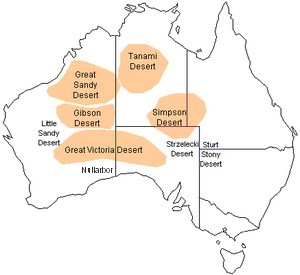http://www.eoearth.org/article/Great_Victoria_desert?topic=74361
http://www.outback-australia-travel-secrets.com/australian_deserts.html
The Great Victoria Desert is the largest desert in the
continent of Australia and the eight largest desert in the world overall,
covering roughly 163900 square miles. It is located in the South-Western region
of Australia, stretching from the Eastern Goldfields of Western Australia to
the Gawler Ranges in Southern Australia.
It is one of the five deserts and among the many different ecosystems
located in the vast but sparsely populated region known as the Australian
Outback.
-http://worldwildlife.org/ecoregions/aa1305
-http://www.outback-australia-travel-secrets.com/australian_deserts.html
The Great Victoria Desert is considered to be a hot, arid
desert, receiving only 150 to 250 mm(5.9 to 9.8 inches) of rain annually. However the rain tends to be random and unpredictable throughout the year. Summers can achieve high temperatures
reaching temperatures of 35 degrees Celsius and in the winter can reach
temperatures below freezing in the middle of the night.
http://www.eoearth.org/article/Great_Victoria_desert?topic=74361
http://home.vicnet.net.au/~fgvd/facts.htm
http://www.outdoorssa.com.au/Feature%20Stories/Coongie%20Lake.htm
The Great Victoria Desert is mostly covered in sand dunes,
especially in the low-elevation areas, dispersed among low ranges, tabletops,
and plains. In other areas, there are
special regions called gibber plains, which are regions of the desert
completely covered in pebbles. Little vegetation can live in this sort of
environment, though during times of rain, some temporary plants will
sprout.
-http://worldwildlife.org/ecoregions/aa1305





No comments:
Post a Comment